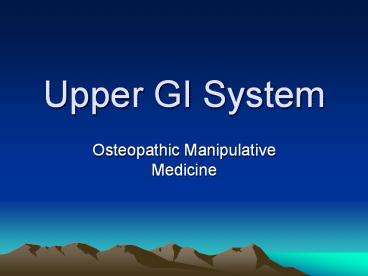Upper GI System - PowerPoint PPT Presentation
1 / 19
Title:
Upper GI System
Description:
Thus myofascial techniques are crucial in ... into ease of motion Tissues Release Retest Take tissues into ease ... Upper Gastrointestinal System ... – PowerPoint PPT presentation
Number of Views:107
Avg rating:3.0/5.0
Title: Upper GI System
1
Upper GI System
- Osteopathic Manipulative Medicine
2
Objectives
- Review previously learned concepts and techniques
which apply to diagnosis and treatment of upper
gastrointestinal disorders - Identify patterns of viscerosomatic reflexes
which correspond to disease processes in
individual organs - Incorporate somatic findings in the diagnosis and
treatment of upper GI disorders
3
Viscerosomatic Reflexes
- DiGiovanna/Schiowitz
- T5-6R - upper esophagus
- T6-9R - liver and gall bladder
- T8-9B - small intestine
- T5-9L - lower esophagus and stomach
- T6-9L - spleen and pancreas
- Musculoskeletal pain related to visceral
dysfunction may be the sole presenting symptom of
viscerosomatic reflex
4
Techniques
- Thoracic Techniques - Sympathetics
- HVLA
- Muscle Energy
- Counterstrain
- Soft tissue
- Lymphatic Techniques
- Cranial Cervicals - Parasympathetics
- Vagus (Cranial nerve 10)
5
Fascia
- Fascia directly or indirectly influences the
health of the body through coordination with the
musculoskeletal system, cooperation in
circulating body fluids, and by allowing generous
passageway for nerves. Derangement in the
fascial planes can result in veinous congestion,
abnormal reflexes, and a decreased range of
motion. Thus myofascial techniques are crucial
in eliminating fascial restrictions and allowing
the body to return to a healthier state.
-DiGiovanna
6
Myofascial Techniques
- Motion Testing
- Take tissues into ease of motion
- Tissues Release
- Retest
- Take tissues into ease of motion
- Continue until motion is free
7
Chapmans Reflexes
- myofascial tender points related to specific
visceral dysfunction - helpful in diagnosis
- anterior points more helpful - more tender
- firm gentle contact with rotary motion to
dissipate the swelling
8
True visceral pain
- pacinian corpuscles
- free nerve endings
- activated by spasm or stretch
- carried by visceral afferents
- midline pain, poorly localized-vague, deep,
diffuse, burning ache
9
Viscerosomatic Pain
- pain receptors in anterior and lateral parietal
peritoneum, lesser omentum, mesentaery, mesocolon - facilitated cord segments in somatic areas
related to the visceras sympathetic innervation
10
Viscerosomatic Reflexes
- alerts clinician to look for visceral cause
- HVLA is often ineffective - met with a rubbery
resistance
11
Sympathetics
- rapid and widespread organ and somatic changes
required to meet stress (flight/fight) - activation of one sympathetic fiber produces 4 to
40 post ganglionic fiber activations
12
Parasympathetics
- dominate innervation during restful activity
- Vagus, CN X, exits via jugular foramen
- left - greater curvature of stomach, duodenum
- right - lesser curvature, small intestines, right
colon, and organs and glands up to midtransverse
colon - stimulation will increase secretion rate of most
glands
13
Lymphatics
- flow of lymph may be hindered by poorly
efficient, flattened diaphragm, torsion of the
fascias around the lymphatic channels - slight impedance of lymphatic pathways or
hindrance to the function of the diaphragm can
reduce the bodys ability to recover from a
disease process
14
Somatic system
- somatic pain may persist even after the visceral
problem has resolved - treatment is OMT
- examples
- Peptic ulcer disease
- Postcholecystectomy syndrome
15
Treatment of Upper GI disorders
- Osteopathic treatment is directed toward
improving the physiologic function of the patient - Treatment will
- reduce need for pain medication
- balance autonomic activity
- improve lymphatic flow
16
Goals of OMT
- improve visceral response to stress
- relieve congestion
- improve circulation
- enhance removal of waste products
- improve cardiac output
- improve oxygenation and nutrition (cellular)
- enhance medication effectiveness
- relaxation and comfort - diagnosis/treatment
17
TreatmentLymphatics and Fascias
- Mesenteric lift (small intestines) - frees
lymphatic pathways - lift upward and to right
side of abdomen - respiratory cooperation - Visceral manipulation of individual viscera
- Doming of diaphragm
- Lymphatic pump techniques
18
Visceral ManipulationBasic Tenets
- an organ or viscera in good health has
physiologic motion - mobility - voluntary or diaphragmatic
- motility - inherent motion
- restriction implies functional impairment
- motion repeated thousands of times daily can
bring about significant changes to organ and
adjacent structures
19
Upper GI System Osteopathic Clinical Examples
- Diaphragm restriction in GERD
- Midscapular pain treated with NSAIDS may actually
be referred viscerosomatic pain































